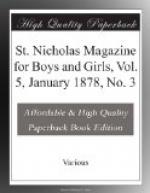[Illustration: A POSTAGE-STAMP HOLDER.]
A letter-case for papa’s other pocket: This can be made either of morocco, oiled silk, or rubber cloth. Cut an envelope-shaped piece, about an inch larger all round than an ordinary letter envelope. Bind the edges, work an initial on one side, and for a fastening use a loop of elastic braid.
SAND-BAGS FOR WINDOWS.
These are capital presents for grandmammas whose windows rattle in winter weather and let cold air in between the sashes. You must measure the window, and cut in stout cotton cloth a bag just as long as the sash is wide, and about four inches across. Stitch this all round, leaving one end open, and stuff it firmly with fine, dry sand. Sew up the open end, and slip the bag into an outer case of bright scarlet flannel, made just a trifle larger than the inner one, so that it may go in easily. Lay the sand-bag over the crack between the two sashes, and on cold nights, when you are asleep, grandmamma will rejoice in the little giver of such a comfortable bulwark against the wind.
RACK FOR TOOTH-BRUSHES, IN RUSTIC-WORK.
This is very simple, but it is pretty as well. Cut two straight spruce twigs, each having two or three little branches projecting upward at an angle of forty-five degrees. These twigs must be as much alike in shape as possible. Place them six inches apart; lay two cross-twigs across, as you see them in the picture, and tie the corners with fine wire, or fasten them with tiny pins. Two diagonal braces will add to the strength of the rack. Hang it to the wall above the wash-stand by a wire or ribbon. The tooth-brushes rest on the parallel branches.
[Illustration: A RACK FOR TOOTH-BRUSHES.]
For further particulars concerning spruce-wood work,
see ST. NICHOLAS,
Vol. III., pp. 114 and 115.
MINIATURE HANGING-SHELVES.
[Illustration: MINIATURE HANGING-SHELVES.]
Boys who have learned to use their pocket-knives skillfully may make a very pretty set of hanging-shelves by taking three bits of thin wood (the sides of a cigar-box, for instance), well smoothed and oiled, boring a hole in each corner, and suspending them with cords, run in, and knotted underneath each shelf as in the picture. The wood should be about eight inches long by three wide, and the shelves, small as they are, will be found convenient for holding many little articles.
PAPER-CUTTERS.
Another idea for these graduates of the knife is this falchion-shaped paper-cutter. It can be made of any sort of hard-wood, neatly cut out, rubbed smooth with sand-paper, and oiled or varnished. It has the advantage that the materials cost almost nothing. Suggestions for more elaborate articles in wood will be given further on.




